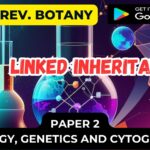![]()
Sex Limited Characters and sex reversal
- Some traits are carried on the sex chromosomes, X and Y. Most traits carried are present on only the X-chromosome.
- The Y-chromosome is smaller, and so, very few genes are located on this chromosome.
- Sex traits can be categorized into three types of inheritance: sex-limited, sex-linked, and sex-influenced.
- Sex-limited traits are traits that are visible only within one sex. For instance, barred coloring in chickens normally is visible only in the roosters.
- Sex-linked traits would be considered traits like sickle cell anemia and color blindness.
- They are said to be linked because more males (XY) develop these triats than females (XX).
- This is because the females have a second X gene to counteract the recessive trait.
- Thus, the trait is more likely to be visible in the male.
- Sex-influenced traits are autosomal traits that are influenced by sex.
- If a male has one recessive allele, he will show that trait, but it will take two recessive for the female to show that same trait.
- One such gene is baldness.
- A lot of sex-limtied traits can determine parental carriers by using a pedigree.
- The colored blocks indicate a recessive trait phenotype, and from there, carriers can be traced back.
- This is an effective method when determining the probability of an offspring receiving that trait.

- If the pedigree is used to analyze the parents genes for hemophilia and S represent affected, then what are the parents?

The answer is:

- Sex-Limited Genes are found in both sexes of sexually reproducing animals, but are expressed in only one and thus have no penetrance in another, or are simply ‘turned off’ in the other. In other words, although possessing the same genotype, Sex-Limited
- Genes cause the two sexes to exhibit different behaviours or phenotypes.
- This term refers to autosomal qualities only, and therefore should not be mistaken with sex-linked features, which refer to genetic variations on the chromosomes of the sexes.
- Sex-restricted genes are separated from sex-influenced genes, which have distinct expression patterns in each sex.
Storage Effect:
- Because Sex-Limited Genes exist in both sexes however are expressed only in one, the unexpressed genes are protected from the selection.
- If talking about a short-term scale, this implies that within one generation, selection would only affect the sex which expresses the sex-limited trait(s) of significance.
- Because these features are buried (unexpressed) in the genes of the opposite sex, the left portion of the gene pool for such traits would be unaffected by selection.
- The phenomenon is known as the ‘storage-effect,’ even though a fraction of the alleles for all these sex-limited features is masked from the selection.
Effects of Sexual Antagonism:
- When two species’ optimal fitness strategies for reproduction collide, sexual antagonism arises.
- A famous example of opposing optimal strategies is multiple matings.
- Males could profit from much more regular matings since they have a lesser investment amount in reproduction.
- Females, on the other hand, put far more effort into reproduction and could be threatened, damaged, or even killed as a result of many matings.
Effects on Animal Behavior:
- Animal behavior is so broad that it appears in practically every primary literature containing live animals in some form.
- Although the instances above involve parts of animal behaviour, a more overt instance of it in regard to sex-limited features and other example of sex limited traits in animals are given in Teplitsky et al. research (2010) focusing on red-billed gull breeding time.
- The subject of this study is breeding time, which is a part of reproductive Biology.
- Reproduction and sexual activity are two important components of animal behaviour that are universally manifested in some form across the animal kingdom.
Sex Linked Character:
- When a gene mutation (allele) is found on a sex chromosome (allosome) instead of a non-sex chromosome (allosome), sex linked characterises the sex-specific patterns of inheritance and presentation (autosome).
- These are referred to as X-linked dominant, X-linked recessive, and Y-linked in humans.
- The inheritance and presentation of any and all three are different based on the parent’s and child’s sex.
- The inheritance and presentation among all three are different based on the parent’s and child’s sex.
- This distinguishes them from autosomal dominance and recessiveness in a significant way.
- Because humans have a few times as many genes on the X chromosome as the Y chromosome, there seem to be significantly more X-linked disorders than Y-linked disorders.
- Because they lack a second X chromosome with a good and healthy copy of the gene, solely females can be carriers for X-linked illnesses; males would always be impacted by an X-linked condition.
- As a result, males are affected far more frequently than females by X-linked recessive diseases.
- A son born to a mother who is the carrier and a father who is unaffected has a 50% chance of being affected, whereas a daughter seems to have a 50% chance of becoming a carrier in X-linked recessive inheritance.
- Due to a phenomenon called skewed X-inactivation, wherein the usual process of inactivating 50 percent of the female body’s X chromosomes preferentially targets a specific parent’s X chromosome (in this example, the father’s), a fraction of carriers might show a milder (or perhaps even full) form of the illness.
- Because the son does not inherit the father’s X chromosome, if the father is sick, the son would not be impacted, but the daughter has always been a carrier.
X-Linked Dominant Inheritance
- Each woman who has an X-linked dominant characteristic has a 50% probability of having the mutation and consequently developing the condition.
- If just the father is impacted, all of the daughters would be affected because they receive their father’s X chromosome, but no sons will indeed be affected because they acquire their father’s Y chromosome.
- Because around half (or as much as 90% in some situations) of a specific parent’s X chromosomes are inactivated in females, X-linked dominant conditions are far less common than X-linked recessive disorders.
Alport Syndrome:
- Alport syndrome is a hereditary illness characterized by glomerulonephritis, end-stage renal disease, and hearing problems that affect 1 in 5,000-10,000 children.
- Alport syndrome can damage the eyes as well, though the alterations normally do not impede vision unless the lens changes later in life.
- Urine with blood is a common occurrence.
- Proteinuria is a symptom of advanced renal disease.
Coffin-Lowry syndrome:
- Coffin-Lowry syndrome is an X-linked dominant genetic condition that causes significant mental disorders, and also heart abnormalities, kyphoscoliosis, growth abnormalities, and hearing and visual abnormalities.
Fragile X Syndrome (FXS):
- The genetic condition Fragile X syndrome (FXS) is characterized by mild-to-moderate intellectual impairment.
- Males have a lower average IQ than females, with roughly two-thirds of those affected being intellectually handicapped.
- A long and narrow face, flexible fingers, huge ears, and huge testicles are all possible physical characteristics.
- Around a third of all those affected show autism symptoms including social interaction issues and speech delays.
- Seizures occur in roughly 10% of people with hyperactivity. Males are much more affected than females in most cases.
Hypoparathyroidism:
- Hypoparathyroidism is a condition in which the parathyroid glands’ function is impaired due to a lack of parathyroid hormone synthesis.
- Low calcium levels in the blood can cause muscle cramping and twitching, as well as tetany (involuntary muscle spasm) and a variety of other symptoms. It’s an illness that only a few people have ever heard of.
- It could be hereditary, however, it is also seen after thyroid or parathyroid gland surgery, and this can be triggered by immune system injury as well as a variety of other less common causes.
- Blood tests as well as other investigations, including genetic testing, are used to make the diagnosis, based on the results.
- Calcium and vitamin D supplementation are the most common treatments for hypoparathyroidism.
X-linked Recessive Inheritance
- Carriers are females that have one X-linked recessive mutation and do not show medical symptoms of the condition.
- However, changes in X chromosome inactivation might contribute to varying degrees of clinical expression in carriers, as certain cells express one X allele while others express another.
- Because males have only one X chromosome and hence only a single copy of X-linked genes, all males with an X-linked recessive mutation would be impacted.
- If the father does not contain the recessive allele, all offspring of a carrier mother have a 50% risk of obtaining the mutation.
- Because daughters inherit their father’s X chromosome, all-female children of an affected father would be carriers (provided the mother is neither affected nor a carrier).
- Because boys only inherit their father’s Y chromosome, unless the mother would not be a carrier, none of the male children of an affected father would be impacted.
- The incidence of X-linked recessive disorders in women seems to be the square of the incidence in men: for instance, if 1 in 20 men in a human community becomes colourblind, then 1 in 400 women in the group are likely to be colourblind (1/20)*(1/20)
Aarskog–Scott syndrome
- Short stature, facial deformities, skeletal and genital malformations are all symptoms of Aarskog–Scott syndrome, a rare X-linked disorder.
- Males are more likely to be affected by this illness, however, females may experience modest symptoms.
Adrenoleukodystrophy
- ALD (adrenoleukodystrophy) is a disease caused by a mutation on the X chromosome.
- A deficiency in the very long sequence of fatty acids transporter in peroxisomes leads to fatty acid accumulation that results in damage to the myelin sheath of the nerves, leading to hyperactivity and seizures.
- Difficulties in talking, hearing and interpreting verbal instructions are among the other signs and symptoms.
Color Blindness
- Color blindness (color vision deficit) is a condition in which a person’s ability to see color or color distinctions is impaired.
- This could make it difficult to do things like pick ripe fruit, dress appropriately, and read traffic lights.
- Some educational tasks may be more challenging if you are color blind.
- However, most color-blind persons adapt, and problems are usually mild.
Fabry Disease
- Fabry disease, commonly referred to as Anderson–Fabry disease is a rare genetic disorder that affects the heart, kidneys, and skin.
- Lysosomal storage diseases are a group of disorders that include Fabry disease.
Sex reversal
- Sex reversal is a redirection of sexual phenotype during embryonic development.
- Most aspects of sexual phenotype, including sex ducts and genitalia, depend on the presence of steroid hormones produced by the testis or ovary.
- The testis or ovary fate of the gonad is decided through a process called sex determination.
- During sex determination, the testis and ovary pathways are mutually antagonistic and compete for control of gonad fate.
- Sex reversal occurs when the sexual trajectory of the gonad is changed to the opposing pathway, switching the sexual phenotype of the organism to the opposite sex.
- In mammals and other vertebrates, where sex is primarily determined by a XX/XY or ZZ/ZW genetic chromosomal system (i.e. genetic sex determination), ‘sex reversal’ refers to the differentiation of a gonadal or sexual phenotype that does not align with genetic sex — for example, the formation of an ovary and female phenotype in an XY animal.
- In species in which sex determination is influenced by the environment (environmental sex determination), sex reversal also refers to a switch in the sexual trajectory of the gonad to the opposing pathway — for example, the formation of a testis and male phenotype under conditions (e.g. temperature) that normally produce females.
- With the exception of fish and birds, functional sex reversal — defined as the ability to produce gametes (sperm or egg) of the opposite sex — can only occur during the early stages of gonad development.
- In all vertebrates, the gonads arise as bipotential primordia composed of progenitor cells that can differentiate into cells of either the testis or the ovary.
- It is this plasticity that makes gonadal sex determination amenable to reversal events, where the fate of the gonad may be switched during sex differentiation, or even as a mature reproductive tissue in fish.
- We can think of sex determination happening in three distinct phases: an initiation phase (when the molecular pathway triggering differentiation of the ovary or the testis is activated), a maintenance phase (whereby the ovary or testis pathway is perpetuated and reinforced while the opposite pathway is repressed), and a later, stabilization phase (when the ovaries or testes become functional) (Figure ).
- During the initiation and maintenance phases, the gonad is still plastic and sexual fate can be switched to the opposing pathway. Sex reversal often occurs because of a failure to maintain the initiated pathway or a failure to repress the opposite pathway.

- In mammals, the sex-determining region of the Y chromosome, Sry, initiates the development of the testis from the bipotential gonad.
- Expression of Sry leads to activation of downstream targets in the testis pathway, such as Sox9.
- These targets repress the ovarian pathway, whilst simultaneously activating and maintaining testis differentiation.
- Sex determination operates like a sensitive balance where any dominating factor may throw the balance in favor of one outcome over the other.
- Mutations that alter the expression levels of crucial, early testis-determining genes, like Sry or Sox9, interfere with their ability to activate the testis pathway and repress the ovarian pathway, and can lead to sex reversal, i.e. the development of an ovary and a female sexual phenotype in an XY individual.
- Sex reversal can also go the other way: when Wnt4, which activates other female pathway genes and represses Sox9, is mis-regulated or missing, the male pathway can dominate and lead to the development of a testis and a male phenotype in an XX individual (even in the absence of the Sry gene).
- As previously mentioned, sex can also be determined through environmental cues, such as temperature.
- For many reptiles, egg incubation temperature provides a dominant sex-determining cue.
- In these species, the plastic period of gonad development is longer than in mammals, lasting between 10 and 20 days.
- A switch in temperature, or exposure of the gonad to hormones, can reverse the sexual trajectory at any time during this period, leading to functional sex reversal in adult life (with the efficiency of reversal decreasing as the end of the maintenance window is reached).






